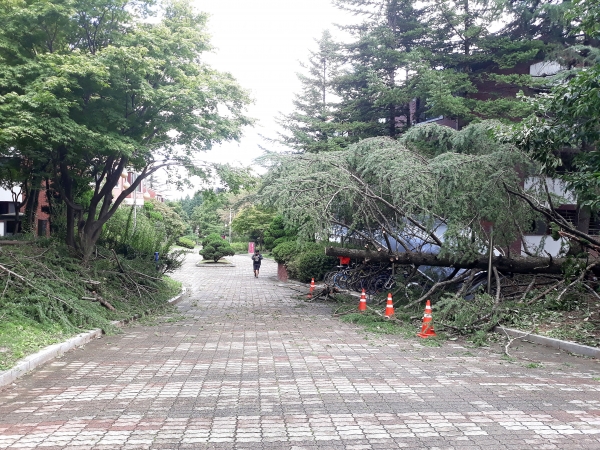
A total of seven typhoons have affected South Korea this year, marking the largest number since observations have been made. The 18th typhoon, Mitag, hit the southern parts of the country on Oct. 3 and caused heavy downpours and strong gusts causing serious damage. Winds were blowing at speeds of 20 to 30 meters per second, and downpours of more than 100 millimeters per hour were reported.
The Central Disaster and Safety Countermeasure Headquarters has reported 10 deaths and 4 people missing since of Oct. 4. Casualties were mostly caused by flooding and landslides. About 750 people were evacuated from their homes and relocated to emergency shelters, and a ministry report said the storm knocked out power to 48,670 homes. A woman in her 70s died in the southeastern city in Pohang, due to the heavy rain causing her home to collapse. In a valley in the north region of Pohang, a car was swept down downstream by torrential rain. It was reported that a driver was in the vehicle, but the fire department was only able to find the vehicle. POSTECH also suffered from heavy rain and strong winds. Some students still had to attend classes in such inclement weather. A tree knocked down by the storm blocked the path leading to Dorm 1 and Dorm 2 causing concern for students.
The government planned to keep track of the exact extent of the damage, while continuing its safety management efforts in areas that are concerned about further damage. Moon Jae-in, president of Korea, posted on social media that “the typhoon has had a severe impact on the country, resulting in deaths and people being forced to leave their homes.” Moon asked the public to offer condolences and support for the victims.
On Oct. 6, the 19th typhoon, Hagibis, developed near the oceans of east Guam. The typhoon intensified in the Western Pacific Ocean with a huge amount of vapor provided from the warm ocean water. On Oct. 12, Hagibis caused serious damage to the eastern and central parts of Japan. Record-setting heavy rains and windstorms have caused flooding and landslides. However, due to the cold continental anticyclone placed on the Korean Peninsula, Hagibis did not have an impact on Korea.
The chances of a typhoon heading towards Korea still exists in winter despite the drop in temperatures. However, due to the deployment of atmospheric pressure in winter, the chances of a typhoon striking during the winter is relatively low.


